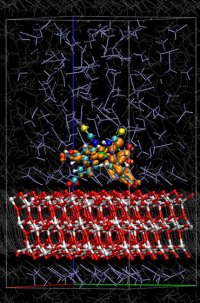Cutting Through Questions for a Molecular-Level Understanding of Solar Cells
Expert discusses molecular modeling and simulation at PNNL seminar
(March 2010)

Shown is a realistic model of a key interface in dye-sensitized solar cells. These models are an essential ingredient in predicting how fast electrons will move across the interface, and thus how efficient the solar cell is. Enlarge Image
Electricity from sunlight could be possible using a robust, low-cost solar cell that uses dyes anchored on inexpensive titanium oxide, rather than highly pure and thus expensive bulk materials. Before commercial applications of these dye-sensitized solar cells are possible, efficiency and stability issues must be resolved. Solving these issues requires a molecular-level understanding of materials and the associated reactions, according to Dr. Joost VandeVondele. A simulation expert at the University of Zurich, VandeVondele discussed his research on these issues at the Pacific Northwest National Laboratory's Frontiers in Catalysis Science and Engineering Seminar. This seminar, part of a series, features academic and other leaders in research and development.
To conduct this research into the behavior of atoms and molecules, VandeVondele and his team turned to CP2K. Known as the Swiss Army knife of molecular simulations, CP2K provides a wide variety of tools for scientists to use in understanding large, inhomogeneous collections of molecules.
Based on the models and simulations they created, VandeVondele and his team obtained a detailed understanding of the reactions that occur at the active interface in the solar cell. These interactions involve energy from sunlight, the gain and loss of electrons from dye molecules, and an iodide-based liquid electrolyte.
Specifically, the team created atomistic models of the dye binding to the titanium oxide surface and demonstrated a highly efficient pathway to regenerate the dye, a reaction that must occur for the cells to function. Also, this work has led to preliminary results for the electronic structure of the full interface and the movement of key electrons.
"Joost convincingly demonstrated the powerful combination of statistical mechanics and electronic structure using scalable software," said Christopher Mundy, a member of the audience and an expert in molecular modeling and simulation at PNNL. "Joost's work is a great example of how molecular simulation can impact our understanding of dye sensitized cells."